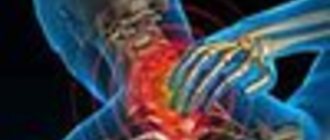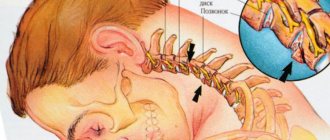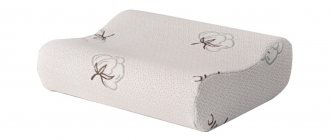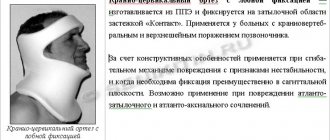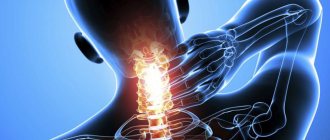Cervical osteochondrosis and vision apparatus
Have you ever wondered how our eyes and neck (cervical spine) are connected?! But this is a very interesting process. How we react to impulses that irritate us... Where this information goes... How it is processed... Our movements and the relationship between the visual apparatus itself and the cervical spine...
Very often we come across patient complaints such as headaches, accompanied at the same time by pressing pain in the eyes, or patients describe the entire course of pain, starting with the shoulder girdle, ending with pain in the cervical region and again pressing pain in the eyes..... We often deal with this we encounter, but sometimes we don’t think about it in everyday life.
What is the mechanism? And where is the connection? If we consider the problems separately, we know that osteochondrosis itself is nothing more than dehydration (dehydration) of intervertebral cartilage; most often we do not notice, see or feel this process, but this soon gives consequences. The fact is that with such deformed cartilage, the vertebrae come closer together, give even greater compression to the intervertebral disc, and then the fun begins! The development of the inflammatory process begins - the disc protrudes slightly into the lumen of the intervertebral canal, and as a result of this, the body gives a reaction - inflammation. In this case, the muscles react with spasm, we feel pain in the muscles of the shoulder girdle, in the neck, in the occipital region. The other side of the coin is the fact that in this case there is a slight displacement of the vertebrae (spondylosis), but this is quite enough for the vertebral arteries to change their course and the process of ischemia (insufficient blood flow) to the brain begins. And already at this stage our vision apparatus will “tell” about this. The patient will complain about pain in the eyes, sometimes blurred vision, flickering spots before the eyes, but doctors will see all the symptoms on the face, or rather in the eyes! Ophthalmologists will notice a narrowing of the visual fields and some exophthalmos. Neurologists will have a much broader picture - neurological symptoms will show: nystagmus, maybe double vision (diplopia) when looking down or straight.
If the process progresses and we do not deal with cervical problems, then in a few years or decades there may be glaucoma.
But it's not all that scary! The fact is that if we treat the manifestations of cervical chondrosis, we can prevent, or at least stop the sad picture. To do this, we use an integrated approach in our treatment methods and prescribe both treatment of cervical osteochondrosis itself (massage, reflexology, manual techniques), and at the same time we prescribe vascular therapy in order to improve microcirculation in the vessels of the brain.
The TRASTMED clinic uses an integrated approach to the treatment of cervical osteochondrosis problems. Doctors have many years of clinical experience in treating this disease, which will definitely ensure a positive effect from the treatment!
Features of the treatment of eye diseases in cervical osteochondrosis
Deterioration of vision with cervical osteochondrosis will not occur without affecting the root cause of the pathological process.
And such a reason is degenerative-dystrophic changes in the spine. Therefore, treatment should proceed in parallel in two directions - restoration of visual functions and articular tissues of the spine. Restoring normal blood supply to the brain, and therefore nutrition of the visual organs, is the main task that the patient must solve together with a neurologist, vertebrologist, or orthopedist.
Clinical symptoms and complaints
Many people do not attach any importance to darkening of the eyes and dizziness, however, such disturbances may indicate the occurrence of cervical osteochondrosis and its negative impact on the organs of vision.
During an examination by an ophthalmologist, the course of the pathological process can be detected. In addition, the patient can independently recognize the course of osteochondrosis by such signs as:
- dilated pupils;
- slight protrusion of the eyeball;
- change in eye shape;
- restriction of eye movement;
- twitching of the eyeball;
- decreased vision.
It is important to promptly determine what led to the occurrence of such disorders, which is why you additionally need to undergo an examination by a surgeon and a vertebrologist, as well as have an MRI and radiography. Blurred vision may be one of the first signs of pathology in cervical osteochondrosis
Periods of darkening of the eyes and sudden dizziness should alert you. Usually they become a reason to consult an ophthalmologist, but the cause should be sought in back diseases
Blurred vision may be one of the first signs of pathology in cervical osteochondrosis. Periods of darkening of the eyes and sudden dizziness should alert you. Usually they become a reason to consult an ophthalmologist, but the cause should be sought in back diseases.
The patient experiences the following symptoms and signs of visual impairment from cervical osteochondrosis:
- sudden darkening;
- tension and pain in the eyes;
- flickering spots of color, fog;
- ghosting and poor focusing;
- decrease in visual fields, as well as acuity.
Osteochondrosis can manifest itself as cataracts - damage to the lens of the eye, manifested by gradual loss of visual fields and decreased vision. With osteochondrosis of the neck, glaucoma can develop in one or two eyes at the same time.
Sometimes there is retinal degeneration, which leads to loss of lateral fields. Complete loss of visual perception is extremely rare, but this possibility cannot be ruled out.
Many patients complain of the appearance of haze in the eyes, rapidly moving black dots, small circles, and string-like objects. Floaters in the eyes with cervical osteochondrosis can be classified as follows:
- Circles of two rings - internal and external.
- Translucent threads with visible circles inside.
- Plexus of twigs - consists of individual threads.
- Various spots and clots. They are similar in outline to clouds, films or flakes. They can cause cloudy areas to appear on the eye or lead to a phenomenon called double vision.
- Black dots moving quickly across the eye. May flicker when moving.
- Sometimes, along with the above-mentioned signs, lightning or sparks flash in the patient’s eyes.
Typically, all of the above signs appear with cervical osteochondrosis in elderly people or myopic patients. Sometimes these symptoms appear in patients with inflammation of the organs of vision.
How to deal with osteochondrosis?
Treatment of osteochondrosis is not a one-time act. It includes a revision of the entire lifestyle. Sufficient physical activity, physical therapy, correct posture, a balanced, varied diet are integral links in the chain of anti-osteochondrosis measures.
It is necessary to supply the body with a sufficient amount of natural vitamins, which will be useful for nourishing both cartilage cells and the organs of vision. And so that the delivery of the “special ration” to the corresponding tissues does not suffer, we must take care of the health of the blood vessels - our main transport arteries. To strengthen vascular walls and increase capillary permeability, give up excess carbohydrates - yes, sweets cause chronic inflammation! But plant flavonoids, antioxidants, Omega-3 fatty acids and other natural substances in your menu can restore elasticity and firmness to blood vessels.
Cartilage regeneration does not occur quickly. But there is a natural remedy that can speed up this process by stimulating the reproduction factors of chondrocytes - cartilage cells. This is the ubiquitous dandelion plant, which we tend to think of as a weed. But in fact, its root is a unique source of substances that are most valuable for cartilage tissue: glycosides taraxacin and taraxacerin, nicotinic acid, inulin and amino sugars.
You should also know about the deep pathogenetic connection between diseases of cartilage tissue and bones. Both of them are based on disorders of mineral metabolism, primarily calcium-phosphorus metabolism. Fortunately, there are remedies that can positively influence the proper distribution of minerals in the body. In nature’s storehouses, these include bee products—drone brood, which have an anabolic effect, that is, stimulating the formation of new connective tissue cells—bone and cartilage.
As we see, visual impairment can be a consequence of problems in the osteoarticular and metabolic systems. In this case, only an integrated approach to healing the whole body can bring recovery.
Treatment
There is no magic cure for this disease. You will have to work long and painstakingly to return to the normal rhythm of life and completely get rid of the pathology. An integrated approach makes the recovery process faster and more effective. It means:
- taking medications, including vitamins;
- physical activity;
- physiotherapy;
- traction;
- massage and manual therapy;
- alternative medicine.
To cure osteochondrosis, you will have to not only conscientiously follow all the doctor’s recommendations, but also change your approach to yourself. First of all, it is recommended to quit smoking, lead a more active lifestyle, and monitor your diet. Orthopedic pillows and mattresses, which help maintain the spine in the correct shape, are good prevention.
A huge number of people over the age of forty suffer from deteriorating vision. Gradually, vision becomes worse and worse, sharpness is lost, everything floats before the eyes, and it is difficult to focus on any object. The reasons may be different, but one of them, which is very common, is osteochondrosis.
In this case, osteochondrosis most likely affected the cervical spine, which is responsible for the blood supply to the brain, in particular the occipital lobe, where the centers of vision are located.
How to restore vision with osteochondrosis?
At the first symptoms of osteochondrosis, it is necessary to consult a specialized doctor as soon as possible. After all, without eliminating the causes that provoked the visual impairment, it will not be possible to restore it. So, to restore the cervical vertebrae the following may be prescribed:
- medications;
- massage of the collar area;
- physiotherapy;
- acupuncture;
- vitamin therapy.
Once blood circulation is restored, visual functions are usually restored. But vision does not always become as sharp as it was before. In this case, it is impossible to do without auxiliary assistance, which may include the use of massage and prophylactic glasses. An innovative development of modern scientists - massage and preventive glasses - help improve the visual function of the eyes, restore blood circulation in them, and normalize intraocular pressure. This device can also be used for prevention. They are prescribed to both adults and children.
If you think that the information on this page will be useful for your friends, acquaintances, colleagues, please repost it to your social media.
networks. To do this, simply click on the corresponding icon: Go back
